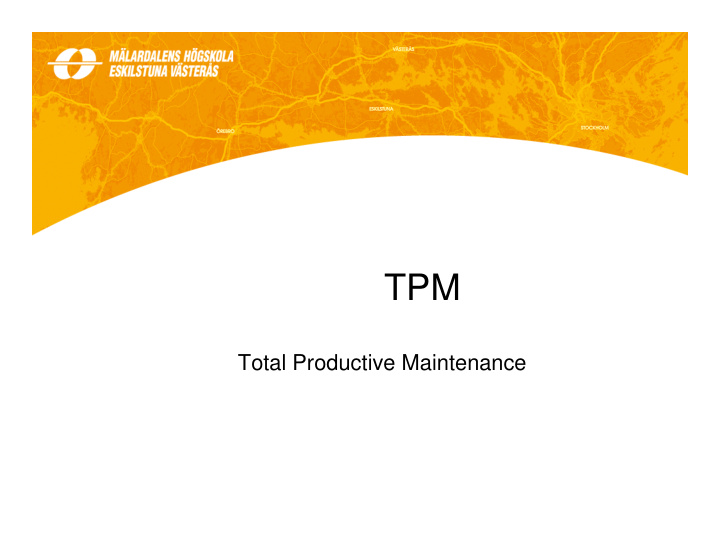



TPM Total Productive Maintenance
TPM - definition TPM can be defined as a systematic work • method aiming to develop disturbance free processes at lowest possible cost through the commitment of all co-workers (LCP-Consultants)
TPM – Total Productive Maintenance Total Effectiveness • Total Preventive Maintenance • Total Commitment •
Why TPM? Replace routine with development • Increased commitment from all co-workers • Continuous improvements • Foreseeable operations • Improved safety and environment •
TPM Structure Evaluation and new goals Preparation Implementation Safety, hygiene and environment Early equipment management Effectiveness Management’s decision Effective administration Quality maintenance Continuous improvements Education Kick-off Autonomous maintenance Organisation and pilot Planned maintenance Policy and goals Education and training Develop a master plan
TPM Structure Evaluation and new goals Preparation Implementation Safety, hygiene and environment Early equipment management Effectiveness Management’s decision Effective administration Quality maintenance Continuous improvements Education Kick-off Autonomous maintenance Organisation and pilot Planned maintenance Policy and goals Education and training Develop a master plan
TPM Structure Evaluation and new goals Preparation Implementation Safety, hygiene and environment Early equipment management Effectiveness Management’s decision Effective administration Quality maintenance Continuous improvements Education Kick-off Autonomous maintenance Organisation and pilot Planned maintenance Policy and goals Education and training Develop a master plan
TPM Structure Evaluation and new goals Preparation Implementation Safety, hygiene and environment Early equipment management Effectiveness Management’s decision Effective administration Quality maintenance Continuous improvements Education Kick-off Autonomous maintenance Organisation and pilot Planned maintenance Policy and goals Education and training Develop a master plan
The six big losses Failures and break-downs • Set-up and adjustments • Idling and minor stoppages • Reduced speed • Defects and rework • Start-up losses •
Sporadic and chronic losses Loss Sporadic fault Optimal condition Chronic faults Time
Sporadic and chronic losses � ������������������������ ����������������������������� �������������� ������� weeks
OEE calculations Planning factor = Available time Planning related Available time – Planning related stop time stopps Planned Available time production time Availability = Failures and breakdowns Planned prod. time – Unplanned stop time Unplanned Available Planned prod. time Set-up and operative time stopps adjustments Idling and Performance rate = Speed loss Net minor stoppage operative Bought CT x items produced time Reduced speed Available operative time Value adding Defects and Defects operative Quality rate = rework time Items produced - Defects Start-up losses Items produced Overall Equipment Effectiveness (OEE) = (Planning factor) x = Availability x Performance rate x Quality rate
OEE meassures TAK KB w6 18 100% 90% 80% 70% 99, 6% 97, 8% 60% 79, 7% 50% 80, 3% 77, 6% 40% 30% 20% 10% 0% Planer ingsf aktor Tillgänglighet Anläggningsutnyttjande Kvalitet TAK
Group activities Autonomous maintenance group Cross functional improvement group Target oriented cross functional group
Quality improvement tools ������ ������������������$� ���������$� �������� ���� �������� ������ ������ ����������!��"������ ��� �������� ������ ����������� ��������� ��#�� ����������� ����������� %��������������������������$���
Example: ABB TAK KB 0,7% 0,5% 0,2% 1,2% 2,1% 100% 7,1% 10,0% 13,3% 90% Kvalitetsförluster 24,3% 7,3% 15,0% 27,9% Hastighetsförluster 11,0% 80% Stillestånd 70% 10,1% Effektivitet 15,1% 60% 50% 82,2% 40% 77,7% 75,0% 64,3% 30% 55,0% 20% 10% 0% Januari Februari Mars April Maj
TPM Structure Evaluation and new goals Preparation Implementation Safety, hygiene and environment Early equipment management Effectiveness Management’s decision Effective administration Quality maintenance Continuous improvements Education Kick-off Autonomous maintenance Organisation and pilot Planned maintenance Policy and goals Education and training Develop a master plan
Autonomous maintenance
Autonomous maintenance Teach the operators to react on cause instead of result • By increased kompetence and understanding the operators may: • � ��������� ��������������� � ������� ����������� � ������ ����������� ������������ � ������� �������������������������������� In the long run operators start to perform maintenance tasks • Daliy inspections replaces repair and low frequent controls • Implemented through seven well-defined steps • Takes long time to implement, often years •
The seven-step ladder Description Competence Repair skills Factory focusing step. 7. Autonomous maintenance From maintenance to control. Understands the 6. Organize the work environment relation between maintenance and Focuses the operators. 5. Autonomous inspection product quality They learn advanced inspection and 4. General inspection training Understands the maintenance techniques functions and structure of the machines Equipment 3. Standards for cleaning and lubrication focusing step. Secures the basic Can find defects and 2. Counter meassures at the problem source condition of the understand the principles for equipment improvements of the 1. Basic cleaning and order equipment
TPM Structure Evaluation and new goals Preparation Implementation Safety, hygiene and environment Early equipment management Effectiveness Management’s decision Effective administration Quality maintenance Continuous improvements Education Kick-off Autonomous maintenance Organisation and pilot Planned maintenance Policy and goals Education and training Develop a master plan
Planned maintenance &��� ����� ��������� �� '(( ����������� ������� ����� ����������� �������� &��� ����� ��������� �� ��������� ���� ����������� �����)����� ����������� ����������������'��( ��������)� ����������� ���)����)������������� ����������� ������� "�������� ����������� ����� ������������ ������� ������� �������������� ���������� ����������� ����� ��� ���������� �� �������� � �!�������� ���"#��$������� ������� ���%���&���#�%�����������%����������
TPM Structure Evaluation and new goals Preparation Implementation Safety, hygiene and environment Early equipment management Effectiveness Management’s decision Effective administration Quality maintenance Continuous improvements Education Kick-off Autonomous maintenance Organisation and pilot Planned maintenance Policy and goals Education and training Develop a master plan
TPM Structure Evaluation and new goals Preparation Implementation Safety, hygiene and environment Early equipment management Effectiveness Management’s decision Effective administration Quality maintenance Continuous improvements Education Kick-off Autonomous maintenance Organisation and pilot Planned maintenance Policy and goals Education and training Develop a master plan
Recommend
More recommend